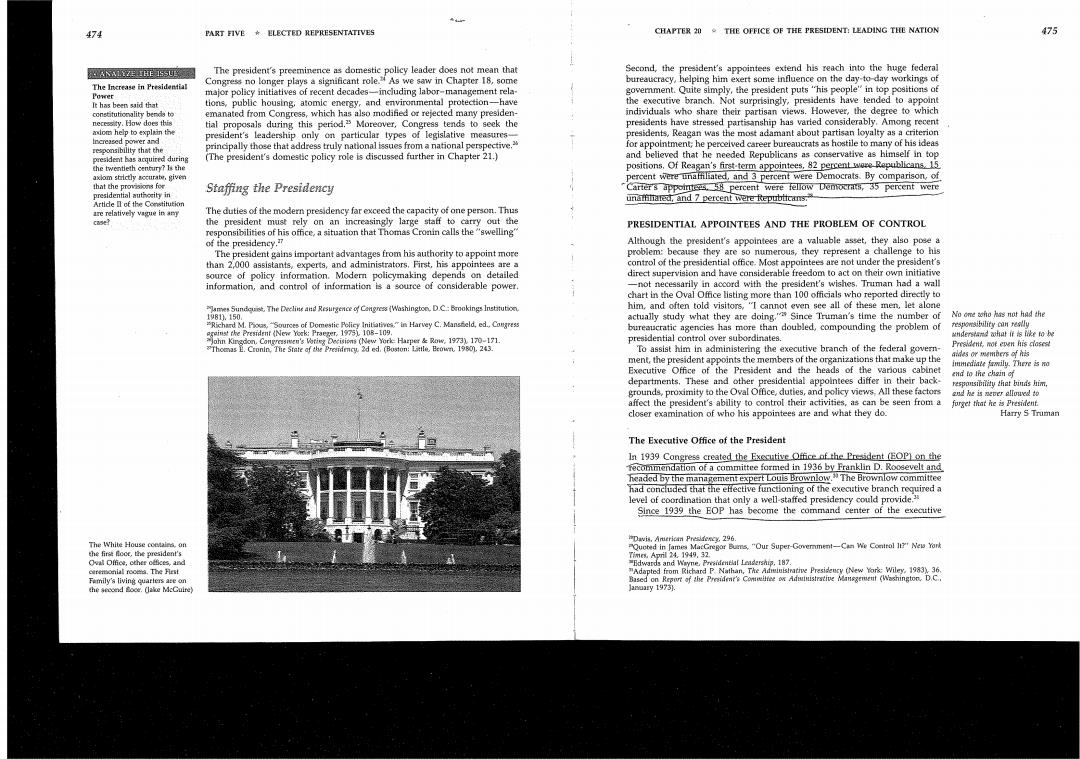正在加载图片...

474 PART FIVE ELECTED REPRESENTATIVES CHAPTER 20 THE OFFICE OF THE PRESIDENT:LEADING THE NATION 475 AA2年E5U The president's preeminence as domestic policy leader does not mean that Second,the president's appointees extend his reach into the huge federal Congress no longer plays a significant role.As we saw in Chapter 18,some bureaucracy,helping him exert some influence on the day-to-day workings of The Increase in Presidential major policy initiatives of recent decades-including labor-management rela- govemment.Quite simply,the president puts"his peopleintopotions af It has been said that tions,public housing,atomic energy,and environmental protection-have the executive branch.Not surprisingly,presidents have tended to appoint 三 emanated from Congress,which has also modified or rejected many presiden- individuals who share their partisan views.However,the degree to which the tial proposals during this period.Moreover,Congress tends to seek the presidents have stressed partisanship has varted considerably.Among recent president's leadership only on particular types of legislative measures- presidents,Reagan was the most adamant about partisan loyalty as a criterion responsibility that the principally those that address truly national issues from a national perspective. for appointment;he perceived career bureaucrats as hostile to many of his ideas president bas acquired during (The president's domestic policy role is discussed further in Chapter 21.) and believed that he needed Republicans as conservative as himself in top the twentieth century?Is the positions.Of Reagan's first-term appointees.82 percent we Republicans 15 axlom stricthy accurab,give percent were unaffliated,and 3 percent were Democrats.By comparison,of that the provisions for Carter's.58 percent were fellow,35 percent were presldential authority in Staffing the Presidency Artide I of the Constitution unaffiliated,and 7 percent were Repubttcans. nw The duties of the modern presidency far exceed the capacity of one person.Thus the president must rely on an increasingly large staff to carry out the PRESIDENTIAL APPOINTEES AND THE PROBLEM OF CONTROL responsibilities of his office,a situation that Thomas Cronin calls the "swelling'" of the presidency." Although the president's appointees are a valuable asset,they also pose a The president gains important advantages from his authority to appoint more problem:because they are so numerous,they represent a challenge to his than 2000 assistants,experts,and administrators.First,his appointees are a control of the presidential office.Most appointees are not under the president's source of policy information.Modern policymaking depends on detailed direct supervision and have considerable freedom to act on their own initiative information,and control of information is a source of considerable power. -not necessarily in accord with the president's wishes.Truman had a wall chart in the Oval Office listing more than 100 officials who reported directly to him,and often told visitors,"I cannot even see all of these men.let alone actually study what they are doing."Since Truman's time the number of No ome softo hs n时had the "Sources of Domestic Policy"in Harvey C.Mansdeld,ed.Cougress esnowaitulity con fesly 兰解 m,1975L10B-109. bureaucratic agencies has more than doubled,compounding the problem of presidential control over subordinates. ndersta=d ahat if的eo To assist him in administering the executive branch of the federal govern- 4写7u州BsC当 ment,the president appoints the members of the make up the 用Had4 wily.There is mo Executive Office of the President and the heads of the various cabinet departments.These and other presidential appointees differ in their back- responsibility hat binds him, grounds,proximity to the Oval Office,duties,and policy views,All these factors 2 nd he i出ver allowed to affect the president's ability to control their activities,as can be seen from a furget that he is President. closer examination of who his appointees are and what they do. Harry S Truman The Executive Office of the President In 1939 Congress created the Executive Office of the President (EOP]on the fecommendation of a committee formed in 1936 by Franklin D.Roosevelt and headed by the management expert Louis Brownlow.The Brownlow committee had concluded that the efective functloning of the executive branch required a level of coordination that only a well-staffed presidency could provide Since 1939 the EOP has become the command center of the executive The White House coetaled on Davis.Arerican Presideecy.296. the fin结cce,e resident's 1949, Our Super-Govemm We Richard P Nathan.The Presidency (New Yors:Wiley.1983)36. the second 1201y1975